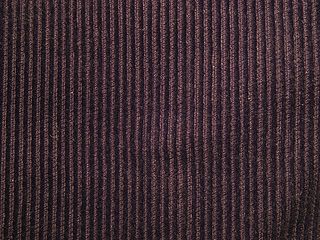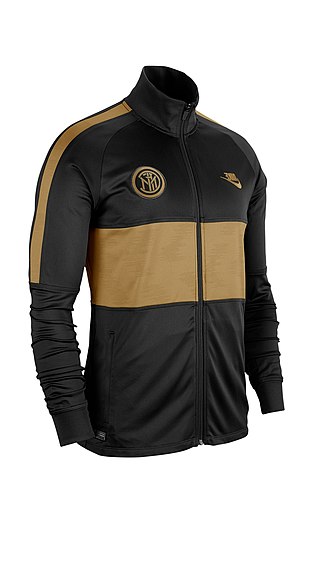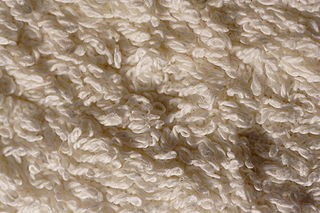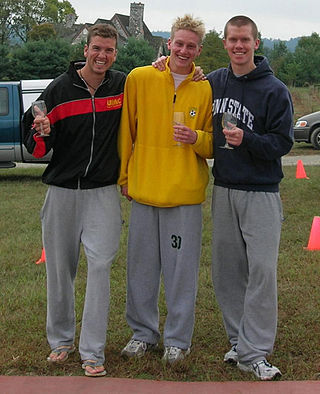
Fashion is a term used interchangeably to describe the creation of clothing, footwear, accessories, cosmetics, and jewellery of different cultural aesthetics and their mix and match into outfits that depict distinctive ways of dressing as signifiers of social status, self-expression, and group belonging. As a multifaceted term, fashion describes an industry, styles, aesthetics, and trends.

Velvet is a type of woven fabric with a dense, even pile that gives it a distinctive soft feel. By extension, the word velvety means "smooth like velvet". Historically, velvet was typically made from silk. Today, velvet can be made from silk, linen, cotton, wool, synthetic fibers, silk-cotton blends, or synthetic-natural fiber blends.

Corduroy is a textile with a distinctively raised "cord" or wale texture. Modern corduroy is most commonly composed of tufted cords, sometimes exhibiting a channel between them. Both velvet and corduroy derive from fustian fabric. Corduroy looks as if it is made from multiple cords laid parallel to each other.

A tracksuit is an article of clothing consisting of two parts: trousers and a jacket usually with front zipper. It was originally intended for use in sports, mainly for athletes to wear over competition clothing and to take off before competition. In modern times, it has become commonly worn in other contexts. The tracksuit was one of the earliest uses of synthetic fibers in sportswear.
Juicy Couture is an American casualwear and dress clothing brand based in Arleta, Los Angeles, California. Best known for their velour tracksuits which became a luxury staple in the 2000s, the company was founded by Pamela Skaist-Levy and Gela Nash-Taylor in 1997 and was later purchased by the Liz Claiborne fashion company in 2003. Juicy Couture has turned into a global seller with their velour tracksuits and other fashions that span clothing, denim, handbags, shoes, intimates, swimwear, fragrance, accessories, sunglasses, yoga and babywear.

Velveteen is a type of woven fabric with a dense, even, short pile. It has less sheen than velvet because the pile in velveteen is cut from weft threads, while that of velvet is cut from warp threads. Velveteen also has a shorter pile than velvet and is stiffer, with less drape, and is usually made of cotton or a cotton-silk blend.

Chiffon (French:[ʃi.fɔ̃];, shif-ON, from the French word chiffe which means "cloth or rag"; is a lightweight, balanced plain-woven sheer fabric, or gauze, like gossamer, woven of alternate S- and Z-twist crepe yarns. Crepe yarn tends to have a tighter twist than standard yarns. The twist in the crepe yarns puckers the fabric slightly in both directions after weaving, giving it some stretch and a slightly rough feel.

Fashion of the 1980s was characterized by a rejection of 1970s fashion. Punk fashion began as a reaction against both the hippie movement of the past decades and the materialist values of the current decade. The first half of the decade was relatively tame in comparison to the second half, which was when apparel became very bright and vivid in appearance.

Terrycloth, terry cloth, terry cotton, terry toweling, terry, terry towel, Turkish toweling (formerly), or simply toweling is a fabric woven with many protruding loops of thread which can absorb large amounts of water. It can be manufactured by weaving or knitting. Terrycloth is woven on special looms that have two beams of longitudinal warp through which the filler or weft is fired laterally.

The fashion of the 2000's is often described as a global mash up, where trends saw the fusion of vintage styles, global and ethnic clothing, as well as the fashions of numerous music-based subcultures. Hip-hop fashion generally was the most popular among young people of all sexes, followed by the retro inspired indie look later in the decade.

Sportswear or activewear is athletic clothing, including footwear, worn for sports activity or physical exercise. Sport-specific clothing is worn for most sports and physical exercise, for practical, comfort or safety reasons.
The manufacture of textiles is one of the oldest of human technologies. To make textiles, the first requirement is a source of fiber from which a yarn can be made, primarily by spinning. The yarn is processed by knitting or weaving, which turns yarn into cloth. The machine used for weaving is the loom. For decoration, the process of colouring yarn or the finished material is dyeing. For more information of the various steps, see textile manufacturing.

Fashion design is the art of applying design, aesthetics, clothing construction and natural beauty to clothing and its accessories. It is influenced by culture and different trends, and has varied over time and place. "A fashion designer creates clothing, including dresses, suits, pants, and skirts, and accessories like shoes and handbags, for consumers. He or she can specialize in clothing, accessory, or jewelry design, or may work in more than one of these areas."

Primarily, nap is the raised (fuzzy) surface on certain kinds of cloth, such as velvet or moleskin. Nap can refer additionally to other surfaces that look like the surface of a napped cloth, such as the surface of a felt or beaver hat.

Bernat Klein CBE was a Serbian textile designer and painter. Based in Scotland, Klein supplied textiles to haute couture designers in the 1960s and 1970s, and later sold his own clothing collections.

Sweatpants are a casual variety of soft trousers intended for comfort or athletic purposes, although they are now worn in many different situations. In the United Kingdom, Ireland, Australia, New Zealand, and South Africa they are known as tracksuit bottoms or trackies. In Australia and New Zealand, they are also commonly known as trackpants, tracky daks or joggers. They are also referred to as jogging pants in Canada.

Athleisure is a hybrid style of athletic clothing typically worn as everyday wear. The word is a portmanteau combining the words 'athletic' and 'leisure'. Athleisure outfits can include tracksuits, sports jackets, hoodies, yoga pants, tights, sneakers, flats, Birkenstocks, uggs, leggings and shorts that look like athletic wear and pair well with it. Characterized as "fashionable, dressed-up sweats and exercise clothing," the growth of the athleisure trend took root during the mid-2010s, which grew out of the popularity of yoga pants that emerged throughout the mid to late 2000s. The convenience of wearing clothes that matched and paired well with yoga pants gave mainstream North American women the agency to exhibit their casual fashion sensibilities for the sake of convenience in multiple occasions without having to change frequently throughout various settings while going on and about their daily lives. Since the mid-2010s, the pervasiveness of the athleisure phenomenon has experienced a significant surge in popularity across Canada and the United States, particularly within the everyday life and daily routines of mainstream North American women. The atheleisure trend entails casual clothing options that give North American women the option to incorporate athletic clothing as part as of their everyday attire, irrespective of their actual engagement in physical activities or not.

The fashions of the 2020s represent a departure from 2010s fashion and feature a nostalgia for older aesthetics. They have been largely inspired by styles of the early-to-mid-2000s, late 1990s, 1980s, 1970s, and 1960s. Early in the decade, several publications noted the shortened trend and nostalgia cycle in 2020s fashion. Fashion was also shaped by the COVID-19 pandemic, which had a major impact on the fashion industry, and led to shifting retail and consumer trends.
An Internet aesthetic, also simply referred to as an aesthetic or microaesthetic, is a visual art style, sometimes accompanied by a fashion style, subculture, or music genre, that usually originates from the Internet or is popularized on it. Throughout the 2010s and 2020s, online aesthetics gained increasing popularity, specifically on social media platforms such as Tumblr, Pinterest, Instagram, and TikTok, and often were used by people to express their individuality and creativity. They can also be used to create a sense of community and belonging among people who share the same interests. The term aesthetic has been described as being "totally divorced from its academic origins", and is commonly used as an adjective.


















